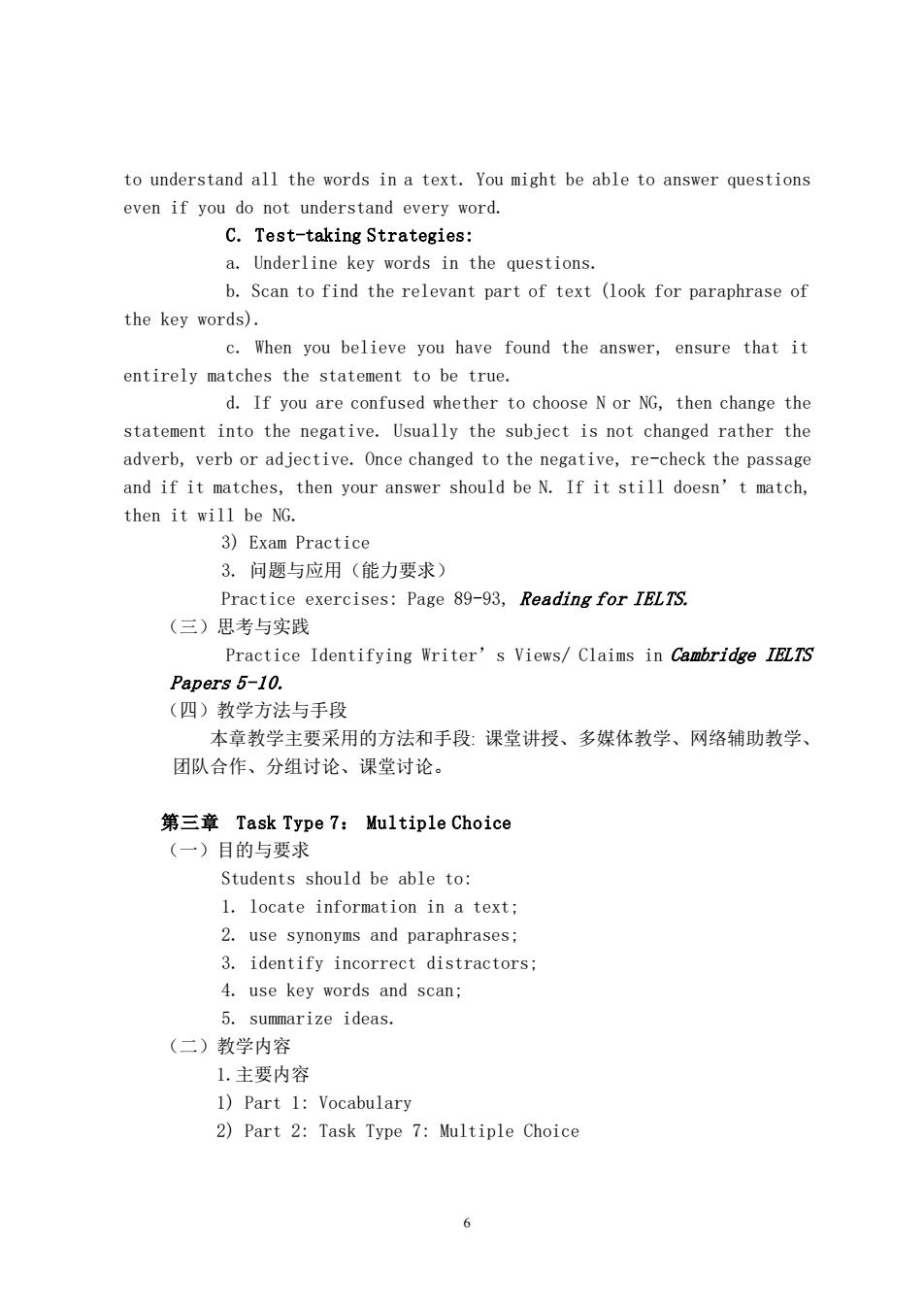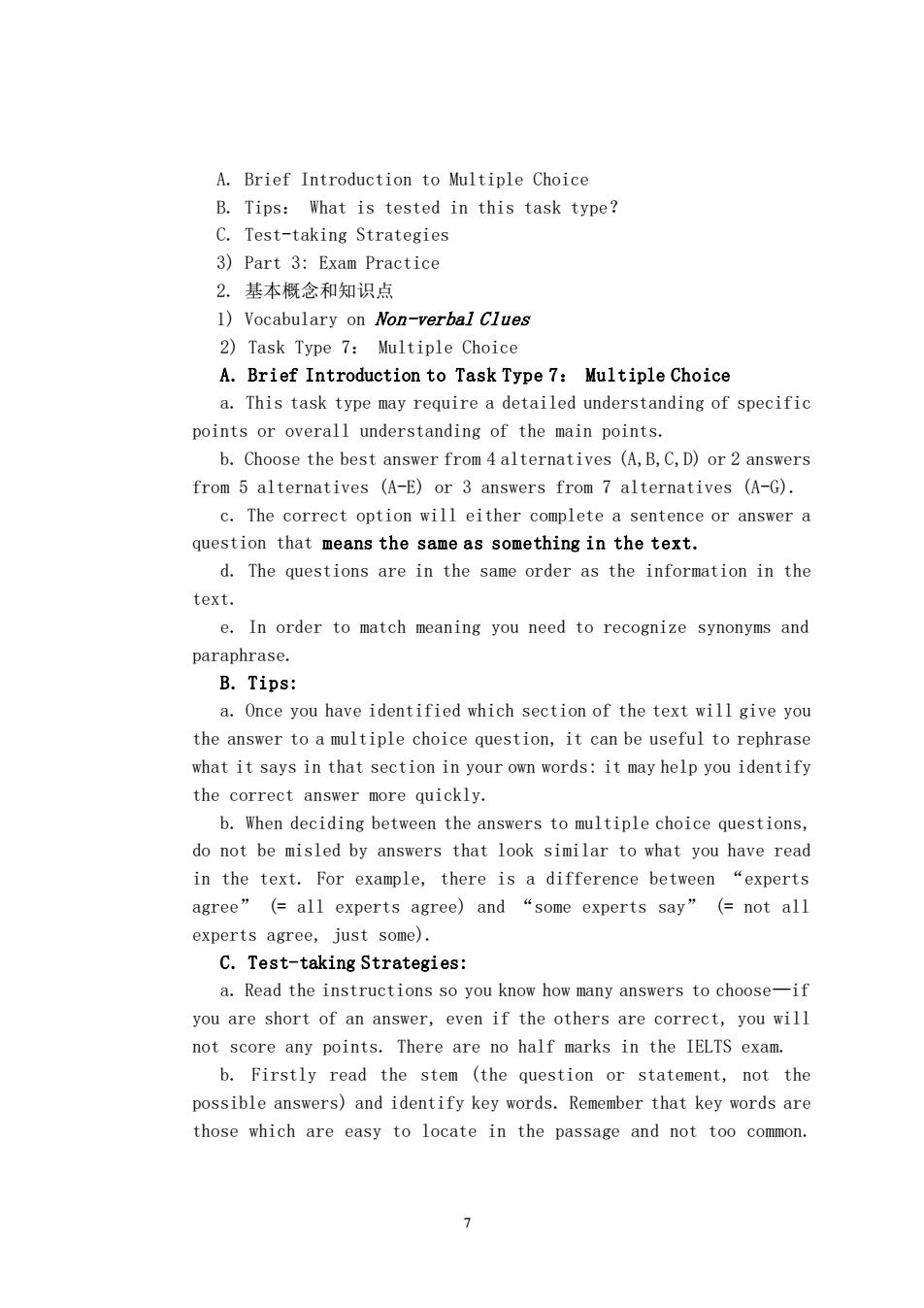
to understand all the words in a text.You might be able to answer questions even if you do not understand every word. C.Test-taking Strategies: a.Underline key words in the questions. b.Scan to find the relevant part of text (look for paraphrase of the key words). c.When you believe you have found the answer,ensure that it entirely matches the statement to be true. d.If you are confused whether to choose n or NG.then change the statement into the negative.Usually the subject is not changed rather the adverb,verb or adjective.Once changed to the negative,re-check the passage and if it matches,then your answer should be N.If it still doesn't match, then it will be NG. 3)Exam Practice 3.问题与应用(能力要求) Practice exercises:Page 89-93,Reading for IELTS. (三)思考与实践 Practice Identifying Writer's Views/Claims in Cambridge IELTS Papers 5-10. (四)教学方法与手段 本章教学主要采用的方法和手段:课堂讲授、多媒体教学、网络辅助教学 团队合作、分组讨论、课堂讨论。 第三章Task Type7:Multiple Choice (一)目的与要求 Students should be able to: 1.locate information in a text; 2.use synonyms and paraphrases: 3.identify incorrect distractors; 4.use key words and scan: 5.summarize ideas. (二)教学内容 1.主要内容 1)Part 1:Vocabulary 2)Part 2:Task Type 7:Multiple Choice 6
6 to understand all the words in a text. You might be able to answer questions even if you do not understand every word. C. Test-taking Strategies: a. Underline key words in the questions. b. Scan to find the relevant part of text (look for paraphrase of the key words). c. When you believe you have found the answer, ensure that it entirely matches the statement to be true. d. If you are confused whether to choose N or NG, then change the statement into the negative. Usually the subject is not changed rather the adverb, verb or adjective. Once changed to the negative, re-check the passage and if it matches, then your answer should be N. If it still doesn’t match, then it will be NG. 3) Exam Practice 3. 问题与应用(能力要求) Practice exercises: Page 89-93, Reading for IELTS. (三)思考与实践 Practice Identifying Writer’s Views/ Claims in Cambridge IELTS Papers 5-10. (四)教学方法与手段 本章教学主要采用的方法和手段: 课堂讲授、多媒体教学、网络辅助教学、 团队合作、分组讨论、课堂讨论。 第三章 Task Type 7: Multiple Choice (一)目的与要求 Students should be able to: 1. locate information in a text; 2. use synonyms and paraphrases; 3. identify incorrect distractors; 4. use key words and scan; 5. summarize ideas. (二)教学内容 1.主要内容 1) Part 1: Vocabulary 2) Part 2: Task Type 7: Multiple Choice

A.Brief Introduction to Multiple Choice B.Tips:What is tested in this task type? C.Test-taking Strategies 3)Part 3:Exam Practice 2.基本概念和知识点 1)Vocabulary on Non-verbal Clues 2)Task Type 7:Multiple Choice A.Brief Introduction to Task Type 7:Multiple Choice a.This task type may require a detailed understanding of specific points or overall understanding of the main points. b.Choose the best answer from 4alternatives (A,B,C,D)or 2 answers from 5 alternatives (A-E)or 3 answers from 7 alternatives (A-G). c.The correct option will either complete a sentence or answer a question that means the same as something in the text. d.The questions are in the same order as the information in the text. e.In order to match meaning you need to recognize synonyms and paraphrase. B.Tips: a.Once you have identified which section of the text will give you the answer to a multiple choice question,it can be useful to rephrase what it says in that section in your own words:it may help you identify the correct answer more quickly. b.When deciding between the answers to multiple choice questions, do not be misled by answers that look similar to what you have read in the text.For example,there is a difference between "experts agree” (=all experts agree)and "some experts say" (not all experts agree,just some). C.Test-taking Strategies: a.Read the instructions so you know how many answers to choose-if you are short of an answer,even if the others are correct,you will not score any points.There are no half marks in the IELTS exam. b.Firstly read the stem (the question or statement,not the possible answers)and identify key words.Remember that key words are those which are easy to locate in the passage and not too common. 7
7 A. Brief Introduction to Multiple Choice B. Tips: What is tested in this task type? C. Test-taking Strategies 3) Part 3: Exam Practice 2. 基本概念和知识点 1) Vocabulary on Non-verbal Clues 2) Task Type 7: Multiple Choice A. Brief Introduction to Task Type 7: Multiple Choice a. This task type may require a detailed understanding of specific points or overall understanding of the main points. b. Choose the best answer from 4 alternatives (A,B,C,D) or 2 answers from 5 alternatives (A-E) or 3 answers from 7 alternatives (A-G). c. The correct option will either complete a sentence or answer a question that means the same as something in the text. d. The questions are in the same order as the information in the text. e. In order to match meaning you need to recognize synonyms and paraphrase. B. Tips: a. Once you have identified which section of the text will give you the answer to a multiple choice question, it can be useful to rephrase what it says in that section in your own words: it may help you identify the correct answer more quickly. b. When deciding between the answers to multiple choice questions, do not be misled by answers that look similar to what you have read in the text. For example, there is a difference between “experts agree” (= all experts agree) and “some experts say” (= not all experts agree, just some). C. Test-taking Strategies: a. Read the instructions so you know how many answers to choose—if you are short of an answer, even if the others are correct, you will not score any points. There are no half marks in the IELTS exam. b. Firstly read the stem (the question or statement, not the possible answers) and identify key words. Remember that key words are those which are easy to locate in the passage and not too common